八年级英语下第六单元教案新教材
- 格式:doc
- 大小:181.00 KB
- 文档页数:20
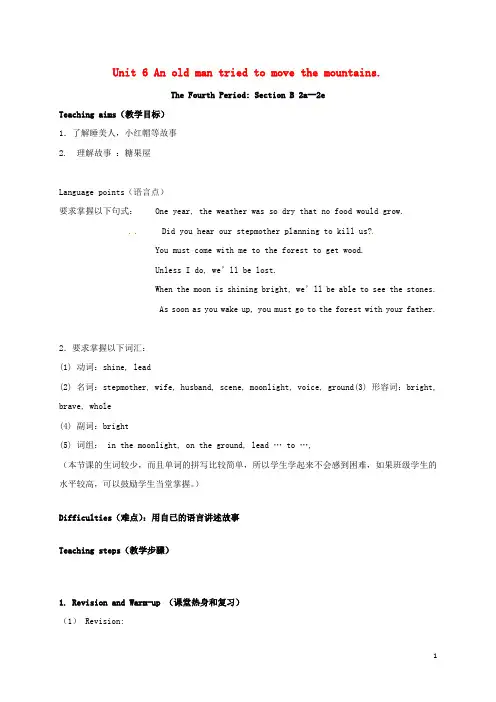
Unit 6 An old man tried to move the mountains.The Fourth Period: Section B 2a--2eTeaching aims(教学目标)1.了解睡美人,小红帽等故事2. 理解故事:糖果屋Language points(语言点)要求掌握以下句式: One year, the weather was so dry that no food would grow.Did you hear our stepmother planning to kill us?You must come with me to the forest to get wood.Unless I do, we’ll be lost.When the moon is shining bright, we’ll be able to see the stones. As soon as you wake up, you must go to the forest with your father.2.要求掌握以下词汇:(1) 动词:shine, lead(2) 名词:stepmother, wife, husband, scene, moonlight, voice, ground(3) 形容词:bright, brave, whole(4) 副词:bright(5) 词组: in the moonlight, on the ground, lead … to …,(本节课的生词较少,而且单词的拼写比较简单,所以学生学起来不会感到困难,如果班级学生的水平较高,可以鼓励学生当堂掌握。
)Difficulties(难点):用自已的语言讲述故事Teaching steps(教学步骤)1. Revision and Warm-up (课堂热身和复习)(1) Revision:A. Translate some phrases.B. Make a dialogue about the story --- The Emperor's New Clothes(让学生以对话的形式进行表演。
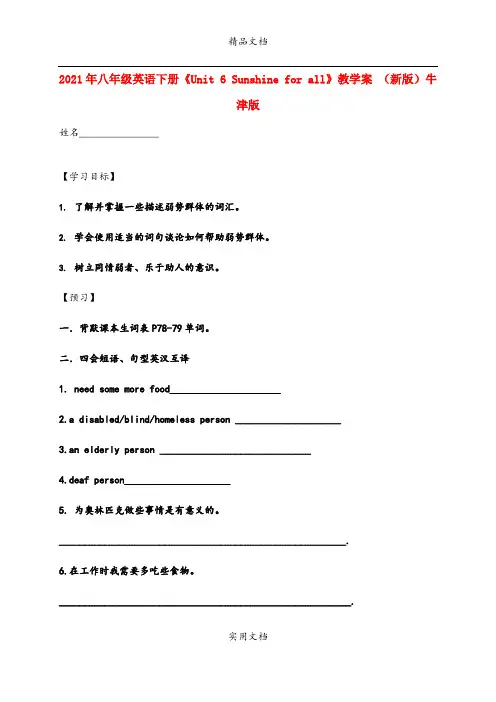
2021年八年级英语下册《Unit 6 Sunshine for all》教学案(新版)牛津版姓名________________【学习目标】1.了解并掌握一些描述弱势群体的词汇。
2.学会使用适当的词句谈论如何帮助弱势群体。
3.树立同情弱者、乐于助人的意识。
【预习】一.背默课本生词表P78-79单词。
二.四会短语、句型英汉互译1. need some more food______________________2.a disabled/blind/homeless person _____________________3.an elderly person ______________________________4.deaf person_____________________5. 为奥林匹克做些事情是有意义的。
_________________________________________________________.6.在工作时我需要多吃些食物。
__________________________________________________________.7.无家可归的人没有自己的地方可住。
___________________________________________________________.8.他们可以提供一些特别的地方给无家可归的人逗留。
__________________________________________________________.【研习】任务一.Listen and answer the questions.1.What is Hobo doing?2.Will Eddie support Hobo? How?3.What does Hobo need Eddie to do?任务二. Act the dialogue out.任务三.完成A部分的练习,学到的短语:______________________________________________________________________任务四、阅读B部分的对话,根据A部分的内容编写新的对话。
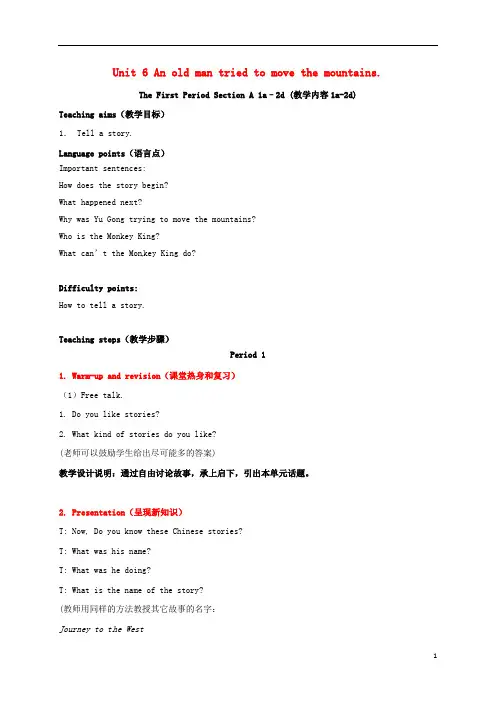
Unit 6 An old man tried to move the mountains.The First Period Section A 1a–2d (教学内容1a-2d) Teaching aims(教学目标)1.Tell a story.Language points(语言点)Important sentences:How does the story begin?What happened next?Why was Yu Gong trying to move the mountains?Who is the Monkey King?What can’t the Mon key King do?Difficulty points:How to tell a story.Teaching steps(教学步骤)Period 11. Warm-up and revision(课堂热身和复习)(1)Free talk.1. Do you like stories?2. What kind of stories do you like?(老师可以鼓励学生给出尽可能多的答案)教学设计说明:通过自由讨论故事,承上启下,引出本单元话题。
2. Presentation(呈现新知识)T: Now, Do you know these Chinese stories?T: What was his name?T: What was he doing?T: What is the name of the story?(教师用同样的方法教授其它故事的名字:Journey to the WestYu Gong Moves a MountainHou Yi Shoots the SunNu Wa Repairs the Sky教学设计说明:教师利用对图片的讨论和问答教授四个故事的名字,形象生动,且能了解故事概要。
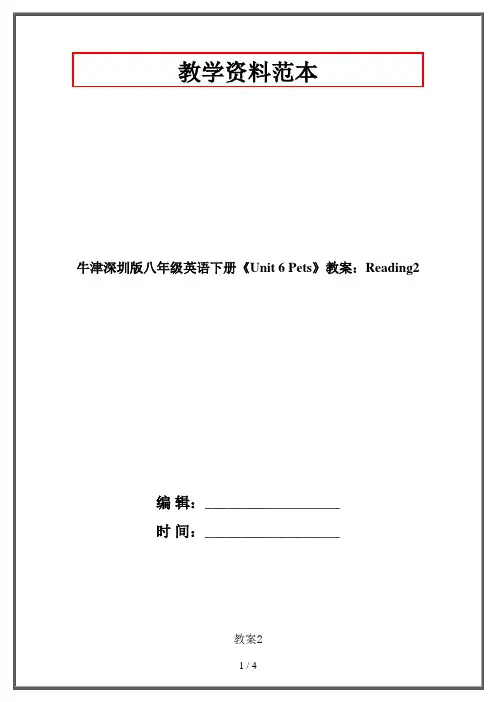
课题Unit6 pets 课型R eading (2)备课时间1 period教材分析教学目标1. Students can know how to use related expressions todescribe your pets.2. Develop the reading ability by finding the clues tosupport your ideas.教学重点Let students know how to use the words and expressionsto talk about your different ideas on pets.教学难点How to use your clues to support your idea.教学关键To tition教法与学法指导R, cooperation, self-study.教学环节主要教学步骤或内容学生主体活动教师活动设计意图时间分配第一环节复习回顾平移的基本性质,引入课题Step one: review aboutthe new words and theexpressions1. Think and guessthe new words ofthe text accordingto the teacher’sEnglish .1. Show theEnglishexplanationsof the wordand ask themto do a quiz.1. Toreview andlead them topave the wayto this unit.5第二环节观察操作、探索归 Step two: Fast reading 2. Read the textquickly and answerthe questions of Bon p82.2. Show theWays of fastreading andthe task:answer thefollowingquestions:1.What do youthink the2.Let thestudents getthe generalidea of thetext..25纳平移的作法Step three: while-reading.RStep four: Discussion 3. Read the textin details andfinish the blankexercise on p85,then check theanswers.4. Talk in group :List the clues tosupport your idea.FOR: 1. dogs arereally cute.2. we can learn.AGAINST: 1. dogsare dirty.2.dogs are noisy.articleabout? 2.wholikes keepinga pet? Whodoesn,t?3. oragniazethe4. Showexamples ofclues tosupport thetwo ideas.3.To makethem getfamiliar withthe detailsof the textand traintheir abilityof reading4. Train thestudentsspeakingability andcooperationability.第三环节课堂练习Step five: Activity:DEBATE COMPETITION5. Choose an ideaand list thereasons and cluesto support youridea.5.encouragethem toorganiz5. To trainthestudents’imagination,creativityand speakingability .5第四环节课时小结step Six: Sum up 6 Sum up : Howcan we express ourideas clearly?First, second,….What’s more.6. Help themfind out thewords to arrangeyour ideas.6. Prepare for the writing5第五环节课后作业 Homework 1. Read the textfluently and writea summary aboutthe text.Hand outwriting thesummaryStrengthenthe课堂教学流程Free talk --- Preparation ---Reading ----- debate —exercise—sum up--Homework.效果评价与反思。
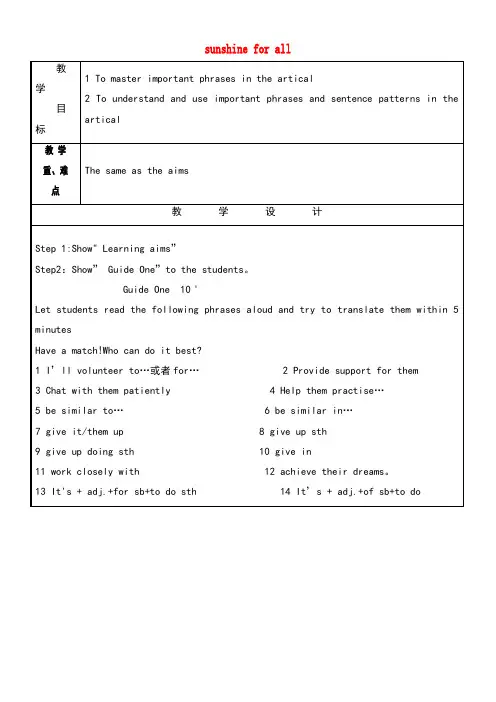
sunshine for allA。
such fine B。
such a fine C。
so fine D。
so fine a( )6。
My father has many books, but he has only_____________ English books。
A。
little B. a little C. few D. a few( )7.One of the twin brothers is training _____________ the sports meeting.However, the other is training_____________ a doctor。
A。
for, to be B。
as , for C。
for, for D。
as, asDo exercises(二)用动词的正确形式填空:1。
Although the problem was hard to understand, the teacher didn’t giveup______________ (explain) it again and again.2。
This is the second time that Amy_______________(visit) the Palace Museum.3.They never_________________(chat) with each other when they were yong, did they?4。
-—-—Who___________________(speak) at the meeting this evening? ——-—I think Mr Smith is。
5.Amy can’t go shopping with us because she has____________(look) after her mother at home.6。
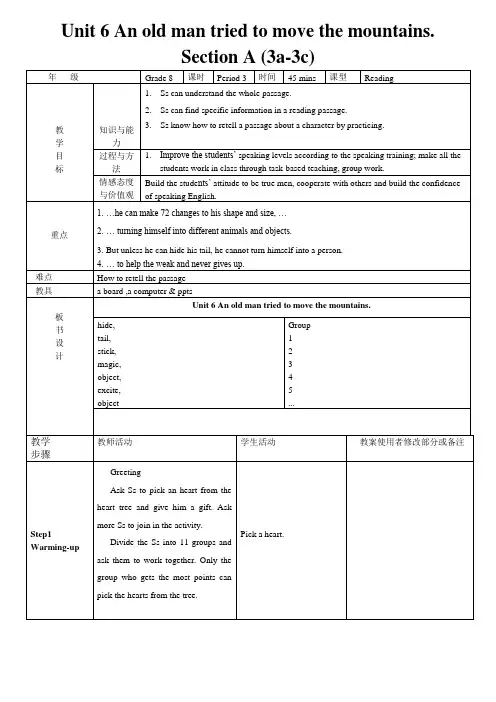
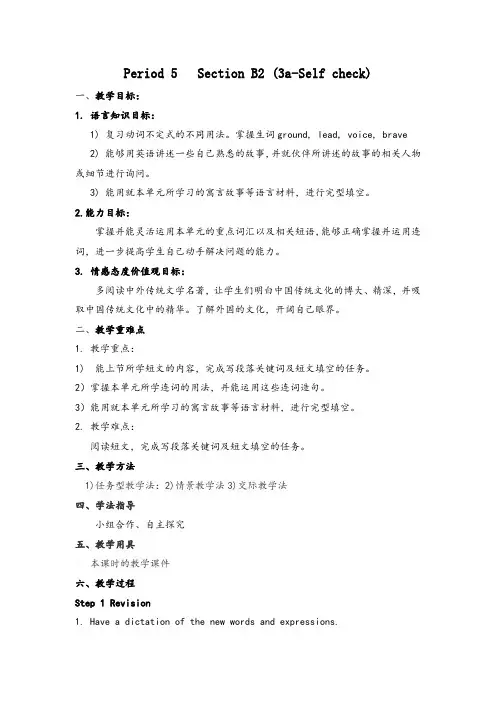
Period 5 Section B2 (3a-Self check)一、教学目标:1. 语言知识目标:1) 复习动词不定式的不同用法。
掌握生词ground, lead, voice, brave2) 能够用英语讲述一些自己熟悉的故事,并就伙伴所讲述的故事的相关人物或细节进行询问。
3) 能用就本单元所学习的寓言故事等语言材料,进行完型填空。
2.能力目标:掌握并能灵活运用本单元的重点词汇以及相关短语,能够正确掌握并运用连词,进一步提高学生自己动手解决问题的能力。
3. 情感态度价值观目标:多阅读中外传统文学名著,让学生们明白中国传统文化的博大、精深,并吸取中国传统文化中的精华。
了解外国的文化,开阔自己眼界。
二、教学重难点1. 教学重点:1) 能上节所学短文的内容,完成写段落关键词及短文填空的任务。
2)掌握本单元所学连词的用法,并能运用这些连词造句。
3)能用就本单元所学习的寓言故事等语言材料,进行完型填空。
2. 教学难点:阅读短文,完成写段落关键词及短文填空的任务。
三、教学方法1)任务型教学法:2)情景教学法3)交际教学法四、学法指导小组合作、自主探究五、教学用具本课时的教学课件六、教学过程Step 1 Revision1. Have a dictation of the new words and expressions.2. Review the main sentences in the play.3. Let Ss act out the play in groups.Step 2 WritingWork on 3a:1. Tell Ss what they should do.2. The key words in a scene help you know the main meaning of the play. Read the story again and write some key words from each scene.阅读指导:每场剧中,确定最重要的一些人物的活动。
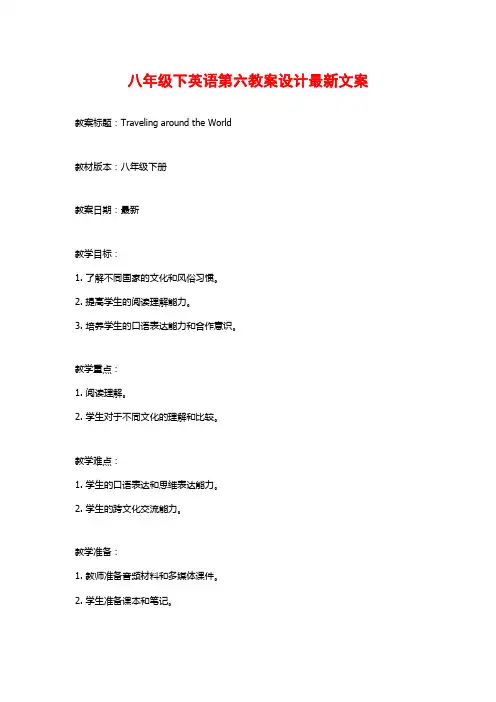
八年级下英语第六教案设计最新文案教案标题:Traveling around the World教材版本:八年级下册教案日期:最新教学目标:1. 了解不同国家的文化和风俗习惯。
2. 提高学生的阅读理解能力。
3. 培养学生的口语表达能力和合作意识。
教学重点:1. 阅读理解。
2. 学生对于不同文化的理解和比较。
教学难点:1. 学生的口语表达和思维表达能力。
2. 学生的跨文化交流能力。
教学准备:1. 教师准备音频材料和多媒体课件。
2. 学生准备课本和笔记。
教学过程:Step 1: Warm-up (5 minutes)通过播放一段关于不同国家风土人情的音频,引导学生回忆并谈论自己所了解的国家的文化和风俗习惯。
Step 2: Pre-reading (10 minutes)通过展示一些图片和文字说明,让学生预测将要读的文章内容,并提出相关问题来引导学生思考。
Step 3: Reading (15 minutes)学生阅读教材中的文章,并尝试用自己的话概括文章的内容。
随后,教师逐段带领学生理解文章并解答相关问题。
Step 4: Discussion (10 minutes)学生分组讨论并分享自己对于文章的理解和对比分析。
教师适时给予指导和评价,并鼓励学生多表达自己的观点。
Step 5: Listening (15 minutes)教师播放一段与文章主题相关的听力材料,并让学生跟读和回答相关问题。
重点培养学生的听力和口语表达能力。
Step 6: Speaking Activity (15 minutes)学生根据所听内容,进行角色扮演,模拟在不同国家旅行时的对话情景。
教师适时给予指导和评价,并鼓励学生积极参与。
Step 7: Consolidation (10 minutes)学生回顾本节课所学内容,总结自己的收获和不足,并给予学生一些建议和指导,以提高学习效果。
Step 8: Homework (5 minutes)布置适当的作业,要求学生通过互联网或其他途径了解一个他们感兴趣的国家的文化和风俗,并写一篇短文进行介绍。
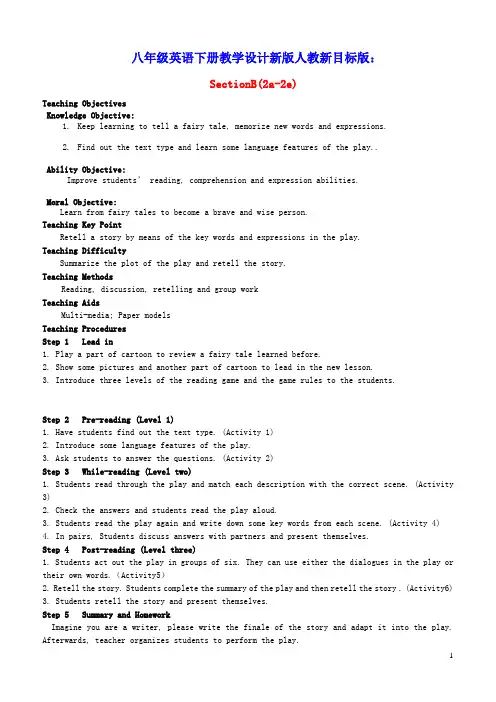
八年级英语下册教学设计新版人教新目标版:SectionB(2a-2e)Teaching ObjectivesKnowledge Objective:1.Keep learning to tell a fairy tale, memorize new words and expressions.2.Find out the text type and learn some language features of the play..Ability Objective:Improve students’ reading, comprehension and expression abilities.Moral Objective:Learn from fairy tales to become a brave and wise person.Teaching Key PointRetell a story by means of the key words and expressions in the play.Teaching DifficultySummarize the plot of the play and retell the story.Teaching MethodsReading, discussion, retelling and group workTeaching AidsMulti-media; Paper modelsTeaching ProceduresStep 1 Lead in1. Play a part of cartoon to review a fairy tale learned before.2. Show some pictures and another part of cartoon to lead in the new lesson.3. Introduce three levels of the reading game and the game rules to the students.Step 2 Pre-reading (Level 1)1. Have students find out the text type. (Activity 1)2. Introduce some language features of the play.3. Ask students to answer the questions. (Activity 2)Step 3 While-reading (Level two)1. Students read through the play and match each description with the correct scene. (Activity 3)2. Check the answers and students read the play aloud.3. Students read the play again and write down some key words from each scene. (Activity 4)4. In pairs, Students discuss answers with partners and present themselves.Step 4 Post-reading (Level three)1. Students act out the play in groups of six. They can use either the dialogues in the play or their own words.(Activity5)2. Retell the story. Students complete the summary of the play and then retell the story . (Activity6)3. Students retell the story and present themselves.Step 5 Summary and HomeworkImagine you are a writer, please write the finale of the story and adapt it into the play. Afterwards, teacher organizes students to perform the play.Blackboard Design。
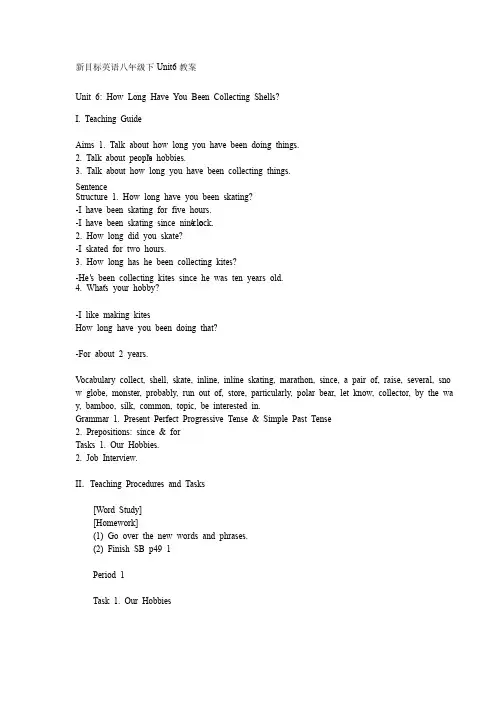
新目标英语八年级下Unit6教案教案Unit 6: How Long Have You Been Collecting Shells? I. Teaching Guide Aims 1. Talk about how long you have been doing things. 2. Talk about people's hobbies. 3. Talk about how long you have been collecting things. Sentence Structure 1. How long have you been skating? -I have been skating for five hours. 'clock. -I have been skating since nine o2. How long did you skate? -I skated for two hours. 3. How long has he been collecting kites? -He's been collecting kites since he was ten years old. 4. What's your hobby? -I like making kites How long have you been doing that? -For about 2 years. V ocabulary collect, shell, skate, inline, inline skating, marathon, since, a pair of, raise, several, sno w globe, monster, probably, run out of, store, particularly, polar bear, let know, collector, by the wa y, bamboo, silk, common, topic, be interested in. Grammar 1. Present Perfect Progressive Tense & Simple Past Tense 2. Prepositions: since & for Tasks 1. Our Hobbies. 2. Job Interview. II.Teaching Procedures and Tasks [Word Study] [Homework] (1) Go over the new words and phrases. (2) Finish SB p49 1 Period 1 Task 1. Our Hobbies 1. Lead-in: Show Ss some pictures about people's collections. Then ask them to talk about what they collect. Fill in the table on P 47. And then have a discussion in pairs. I collect... Reasons I would like to collect... shells they are beautiful stamps they are interesting e.g.: I collect shells because they are beautiful. I’d like to collect stamps because they are interesting…2. Listening p 47. 2a, 2b. 3. “The Student Union is going to set up many clubs. They are doing an investigation on students ' hobbies. They want to see want kind of clubs students like to join. Please fill in the investigation form in pairs.”Name Hobby How long Last Time How long Tom play basketball for 3 years yesterday 1 hour Anna dance for 7 years last Sunday 2 hour Jerry swim for 4 years last week 50 minutes e.g. What's your name? What is your hobby? How long have you been playing basketball? -I have been playing basketball for about ten years. How long did you play it yesterday? -I played it for about two hours. 4. Give a report. e.g.: My name is Peter. I have been living in China for about seven years. I like collecting stamps. I have been collecting Chinese stamps since I came to China. I have been collecting over three hun dred Chinese stamps. I like Monkey King stamps best. 5. Grammar Focus: The difference between “since” and “for”The skating marathon has been going for eight hours. I have been collecting kites for seven years. He has been watching English movies since 1998. I have been listening to music videos since I was seven years old. for: (prep) 表示时间的持续,后面加时间段,表示一段时间,多与带数词的名次连用,其谓表示时间的持续,后面加时间段,表示一段时间,多与带数词的名次连用,其谓语需用延续性动词。
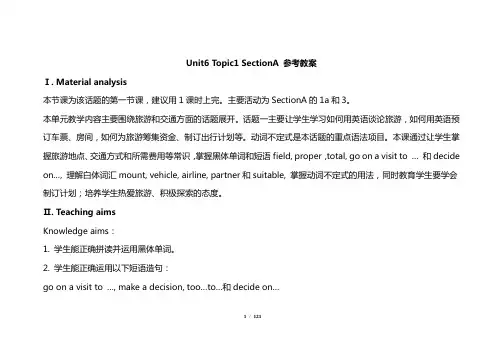
Unit6 Topic1 SectionA 参考教案Ⅰ. Material analysis本节课为该话题的第一节课,建议用1课时上完。
主要活动为SectionA的1a和3。
本单元教学内容主要围绕旅游和交通方面的话题展开。
话题一主要让学生学习如何用英语谈论旅游,如何用英语预订车票、房间,如何为旅游筹集资金、制订出行计划等。
动词不定式是本话题的重点语法项目。
本课通过让学生掌握旅游地点、交通方式和所需费用等常识,掌握黑体单词和短语field, proper,total, go on a visit to …和decide on…, 理解白体词汇mount, vehicle, airline, partner和suitable, 掌握动词不定式的用法,同时教育学生要学会制订计划;培养学生热爱旅游、积极探索的态度。
Ⅱ. Teaching aimsKnowledge aims:1. 学生能正确拼读并运用黑体单词。
2. 学生能正确运用以下短语造句:go on a visit to …, make a decision, too…to…和decide on…1/ 1213. 学生能自如地运用以下句式进行交流:I have some exciting news to tell you.We’re going on a three-day visit to Mount Tai.It will take us a few days to get there by bike.It costs …Let’s decide.We’ll decide on the best way to travel on our field trip. 4. 学生能简单地掌握动词不定式的用法。
Skill aims:1. 能听懂有关旅游的短文或对话,并从中获取信息。
2. 能使用英语与他人谈论关于旅游的话题。
3. 能理解有关旅游、预订等方面的叙述,并从中获取需要的信息。
Teaching plan for 8B Unit6 Sunshine for allReading I教案Teaching objectives:By the end of the class, students will be able to:1. use the new words and expressions in the report.2. know more about the Special Olympics and volunteers.3. improve the ability in careful-reading for more details.4. be willing to join public welfare activities and help others.Teaching important and difficult points:1. Improve reading strategies and the ability in careful-reading for more details.2. Be ready to be a volunteer to help others.Teaching procedures:Step1 Lead in1. Introduce myself to the students.Q: Are my students helpful?2. Watch a short video.Step2 Pre-readingActivity1: Read a story about a boy called Su Fang and teach new words.Step3 While-readingActivity2: Fast-readingRead the text quickly and find out the answers to the questions in the report.Q1: Who is the volunteer?Q2: What did he volunteer for?Activity3: Careful-reading1. Read Para2 and answer the questions.Q1: Who are the Special Olympics for?Q2: What events do the Special Olympics include?2. Read Para3 and find out the verbs about volunteers. Then tell the partner what to do.3. Read Para4 and do the following things:(1) Q: What did Liu Ming do in the Special Olympics?(2) Fill in the blanks about Li Hai.(3) Have an interview.4. Read Para1 &5 and answer the question.Q: How did Liu Ming feel?Step4 Post-readingActivity4: Discuss and make posters. (in the special school, in the home for the elderly, in the poor area, in our daily life)Remember: Make our world full of love!Homework: 1. Try to be a volunteer to help others.2. Read the text fluently.3. Finish the exercises in the workbook.。
人教版八年级下册Unit6单元设计单元分析分析课标:1. 能够用英语简单讲述和撰写熟悉的中外故事。
能够恰当地使用连词和目标语言完成故事的讲述和表演。
3.能根据人物对白总结故事情节要点,根据故事情节发展合理续写故事结局。
4. 了解戏剧体裁,会表演故事。
5. 了解中西方文化的不同,开阔眼界,吸取精华。
分析教材:本单元内容是人教版八年级下册第六单元(Unit 6 An old man tried to move the mountains.),有四部分组成。
Section A部分的主题是中国民间神话故事。
本部分以中国神话故事为主线,要求学生能听懂用英语叙述的这几则故事,并能根据故事的相关信息发表自己的观点,模仿和运用语言。
Grammar Focus 部分归纳梳理了谈论和叙述故事所用的一些问句及句式,主要训练学生在讲故事的过程中合理运用as soon as, unless, so…that 连接句子,使句子连贯,句意通顺,情节紧凑。
Section B 部分的话题主要涉及西方童话故事《皇帝的新装》,《糖果屋》等,在目标语言方面,该部分拓展了关于故事叙述的词汇和句式,阅读输入部分采用了戏剧的形式来展现童话故事。
通过该部分的听说读写训练活动,学生能够更好地运用动词短语以及连词讲述故事。
Self Check 部分要求学生通过单元学习,总结归纳重点词汇及句型,进一步明确as soon as, unless, so…that的恰当表达。
分析学情:本单元是关于中国神话故事和西方童话故事的话题,学生对汉语故事都非常熟悉也很感兴趣。
八年级学生具备了初步的听说读写能力,已经掌握了一般过去时的表达,以及如何用一般过去时讲述故事。
本单元通过听说读写等训练活动,要求学生能够更好地运用动词短语以及连词讲述故事。
单元主题Legends and stories单元目标能正确使用关键词汇和短语。
学会在故事叙述中运用as soon as, unless, so…that等连词。
攀枝花市盐边中学八年级英语备课组教案 Unit One What’s the matter? 2014年春季学期 1 本单元主备课人 祝 贺 备课时间 2014年 月 日 教师 任教班级 课题名称 Unit 6 An old man tried to move the mountains.(page41-page48)
一. 教材分析: 本单元内容主要涉及到连词unless, as soon as, 和so…that…等的用法,进一步巩固条件状语从句。本单元出现的阅读类文章都是学生非常喜欢的话题。在教学过程中,要充分激发学生的兴趣。通过本单元的学习,学生能够从时间、地点、人物以及事件等方面描述英文故事。
二. 教学目标: 1. 知识目标: (1)掌握一些相关的词和词组:shoot, stone, weak, god, remind, bit, a little bit, silly, instead of, turn…into, object, hide, tail, magic, stick, excite, Western, once upon, stepsister, fall in love, fit, couple, smile, marry, get married, gold, emperor, silk, nobody, stupid, cheat, stepmother, wife, husband, whole, scene, moonlight, shine, bright, ground, lead, voice, brave等; (2)掌握连词unless, as soon as, 和so…that…等的用法 (3)学生能够从时间、地点、人物以及事件等方面描述英文故事; (4)运用“上下文暗示法”解阅读题和完形填空题。 . ” 2. 能力目标: 掌握并能灵活运用本单元的重点词汇以及相关短语,能够正确掌握并运用连词,进一步提高学生阅读文章的能力,
3. 情感目标: 通过一些经典故事,教学生学会乐于助人,主动地区帮助处于困境中的人们。在生活中,当面对困难的抉择时,要勇敢地面对一切,决不放弃。 三.教学重点:unless, as soon as, 和so…that…等的用法
四.教学难点:对听力材料的理解以及对阅读部分的掌握。 五.课时分配:Period 1 Section A (1a-2d) Period 2 Section B (3a-3c) Period 3 (Grammar focus-Section B 1d) Period 4 Section B (2a-2c) Period 5 Section B ( 2d-self check) Period 6 处理本单元练习题 攀枝花市盐边中学八年级英语备课组教案 Unit One What’s the matter? 2014年春季学期
2 Period 1 Section A (1a-2d) 上课时间: 备课时间: 一、教学目标: 1. 语言知识目标: 1) 能掌握以下单词以及短语:shoot, stone, weak, god, remind, bit, a little bit, silly, instead of. 2) 能熟悉以下句型: What do you think about…? I think it’s a little bit… As soon as the man finished… 2. 情感态度价值观目标: 引导学生只要尽心尽力去做一件事情,一定会有所收获。 二、教学重难点 1. 教学重点: 掌握相关的单词和词组,并能够灵活运用。 As soon as the man finished talking, Yu Gong said that his family could continue to move to the mountains after he died. 2. 教学难点: 学生对听力材料中新句型、新词组的理解。此外,as soon as的用法也是本节课的难点。 三、教学过程 Step1 Greet the whole class as usual. And then learn new words and phrases. Step2 1a Match the story titles with the pictures on page 41. 知识点归纳: try是动词,意为“试图,设法” 如:我正设法算出这道数学题。 动词try还表示“试”、“尝试”,“试用” 你试过种药了吗? 拓展:try搭配的词组:try to do sth设法做某事;try on试穿;try out尝试,实验;try one’s best尽全力;have a try试一下。 随手练:⑴明天我将尽量早来。 ⑵他还没有试穿过这件毛衣。 ⑶我们的老师总是尝试一些新的想法。 ⑷Lucy将尽力赶上其他同学。 ⑸让我试一下。 Step3 Listen and check the facts you hear. Which story are Anna and Wang Ming talking about on page 41 . 攀枝花市盐边中学八年级英语备课组教案 Unit One What’s the matter? 2014年春季学期 3 __________The two mountains were very high and big. __________A very old man tried to move to the mountains. __________A man told Yu Gong that he could never do it. Step4 1c Discuss the questions with your partner on page 41. There are three questions in this part. Step5 Liasten and number the pictures in order to tell the stories. 知识点归纳: Step 6 Listen and circle the words you hear on page 42. Step 7 Look at the pictures in 2a and tell the story in your own words. Step 8 Role-play the conversation. 先带领学生学习书中对话部分所出现的语法知识,新的词组以及新的句型。并要求学生熟读本部分课文。 对话中主要词组: think about, a good way to…, a little bit, try to do…, agree with, give up, instead of, 知识点归纳补充: 一.instead意为“代替”“替代”,作副词用,通常位于句尾。如位于句首时常用逗号与后面阁开。instead 在顺接句子中作“代替”讲,而在转折(或逆转)句子中作“然而”讲。 例如:1.Lily isn't here. Ask Lucy instead. Lily不在这儿,去问Lucy吧. [注意]当instead在祈使句中时,只能位于句末。 2.she didn't answer me, instead, she asked me another question. 她没有回答我,反而问了我另外一个问题。 二.instead of是介宾短语,其意与instead相同,不同之处在于它后面常接宾语,起宾语多由名词、代词、介词、短语、动词 + ing 形式充当。 例如:1.We'll ask Li Mei instead of Mary. 我们将去问李梅而不问玛丽。 2.I'll go instead of her.我会替她去。 三.instead 与instead of的转换。 例如: 1.He didn't answer me, instead, he asked me another question → He asked me another question instead of answering me. 2.I'll of instead of her.→She won't go.I'll go instead 补充内容:愚公移山 Yu Gong Moved the Mountain 攀枝花市盐边中学八年级英语备课组教案 Unit One What’s the matter? 2014年春季学期 4 在冀州的南面,河阳的北面,有两座巍峨的大山,一座是太行,一座是王屋,方圆七百里,有万丈高。There were two high mountains between Jizhou in the south and Heyang in the north. (the south of Jizhou and the north of Heyang) One was called Taihang Mountain and the other Wangwu Mountain. Both of the mountains were very high. 山的北边住着年近90的愚公。由于家门被山挡住,每次外出全家人都要绕过大山,多走很多路。 Just to the north of the mountains lived an old man called Yu Gong who was nearly 90 years old. (Just to the north of the mountains, there was an old man called Yugong who was````) With the two high mountains just in front of his house, his family and he(the whole family) had to walk a long way around the mountains whenever they went out. 一天,愚公把全家人召集到一起,商量着把两座大山移走。妻子说:“凭你的力量,连一座小山丘也移不走,何况这两座大山呢?再说,你就是能移走,那土石往哪里放呢?”愚公说:“渤海那么大,可以把土石扔到渤海里去。” One day, Yu Gong called all his family together to talk about (discuss) how to move the two mountains to other places. His wife said, "An old man like you cannot even move a small hill, not to mention the two high mountains. Even if you can, where can you throw so much earth and stone?" "The Bohai Sea is big enough to contain all the earth and stone," (The Bohai Sea is big enough for us to throw all the earth and stone into it.) Yu Gong said 说干就干,愚公带领子孙们挖起山来。河曲的智叟看见了,笑着阻止道:“你真是太傻了!以你的残年余力,连山上的一根草都动不了,更何况大山?”愚公叹了口气说:“你错了。你想想,我死了以后还有我的儿子,我的儿子又有儿子,子子孙孙没有穷尽!可是山上的土石不会增加,还怕挖不走吗?” So it was decided. (So they began their work immediatly) His children started to dig the mountains, led by the old man Yu Gong. (Yu Gong, leading his children, started to dig the mountains) A man named Zhi Sou saw them working and tried to stop them, (smiling and) saying, "You are so silly! You're so old and weak that you can't even take away the grass and trees. How can you move (let alone) the high mountains?" "You're wrong," Yu Gong said with a sigh. "Look, my sons can continue my work after my death. When my sons die, my grandchildren will continue. So generations after generations, there's no end. But the mountains can't (wouldn’t) grow higher. Do you still say I can’t move them away?(we aren’t afraid that it wouldn’t be moved)" 愚公移山的事很快被玉皇大帝知道了。玉帝被愚公坚韧不拔的精神所感动,便派大力神把两座大山背走了。 Later the Heaven God, upon learning of Yu Gong’s story, was greatly moved. (Later the God knew what Yu